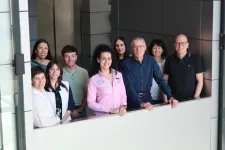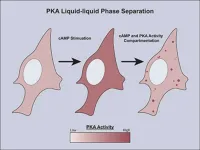(Press-News.org) April 22, 2024
Contact: Lori Atherton, SEAS, lorather@umich.edu
Jim Erickson, Michigan News, ericksn@umich.edu
A new University of Michigan study finds that automation and electrification of long-haul trucking can reduce urban health impacts and environmental damages.
For long-haul routes below 300 miles, electrification can reduce air pollution and greenhouse gas damages by 13%, or $587 million annually, according to the study. For long-haul routes above 300 miles, electrification of just the urban segments facilitated by hub-based automation of highway driving can reduce damages by 35%, or $220 million annually.
"It's the first study we know of that simultaneously studies a realistic model of automation and a realistic model of electrification—things that are feasible in the near term—and assesses their environmental benefits," said lead author Parth Vaishnav, assistant professor at the U-M School for Environment and Sustainability.
Vaishnav explains more about the study, which was published online April 22 in the journal Transportation Research Part D.
Why did you want to focus on how automation and electrification might reduce health and environmental impacts from trucking?
Both automation and electrification of trucking are occurring in parts of the country, but separately. Electrification is difficult for very long routes. Diesel trucks can go 900 miles on a single tank. With today's technology, it is impractical to build an electric truck that can do that, because the battery would be so heavy that the truck would have no capacity to carry any payload. But it's possible to build an electric truck that can go up to 300 miles. Automation is easy on interstates—our past work shows that even truck drivers think that portion of their job can be automated—but very difficult in cities. So, we decided to see what would happen if you combined the best of both worlds: Electrify all routes shorter than 300 miles long and for longer routes, electrify the portion of the route that occurs in cities, but keep human drivers. The benefit of doing this is that you cut tailpipe pollution in places where it can do the most harm, in urban areas where lots of people can breathe it.
What are the study's key takeaways/findings?
There is great environmental and health benefit from electrifying routes shorter than 300 miles: About half a billion dollars' worth of health and environmental harm would be avoided each year. Routes longer than 300 miles are responsible for a smaller share of freight ton miles than are shorter routes. Nonetheless, electrifying even the urban portions on these routes would cut health and environmental harms by over a third, or $200 million per year. That's true with today's grid, which still relies quite heavily on fossil fuels. As we clean up the grid, the benefits will grow.
Did anything surprise you about your findings? If so, what and why?
One of the challenges with using battery electric trucks on short routes is that you face a trade-off between flexibility and efficiency. You want the smallest possible battery that will serve all the routes you want to serve because batteries are heavy, and you don't want to waste energy hauling around extra battery weight. On the other hand, you want the truck to be able to be flexible in what it does; for example, to serve routes of all kinds of different lengths over its lifetime. This means that you want to have a battery that is large enough to serve any route that the truck might be called upon to serve. To our surprise, this efficiency penalty was rather low—about 3%. This is good news, because you can have trucks with a few standard battery sizes without paying a massive efficiency penalty.
What would you like policy makers to take away from your paper in light of the Biden administration's new rules on heavy trucks?
That the electrification of trucking produces outsize benefits, even if it is done with today's technology in niche applications where it makes the most sense. However, these benefits are contingent on deploying a charging infrastructure that works for trucking: This means building out both chargers and strengthening the electricity grid. The broader lesson is that there is a lot of room for both regulatory and operational creativity. For example, we assume that long-haul routes can be split into interstate and urban legs, and that before a truck enters or leaves the interstate, it stops to switch the trailer from an electric to diesel prime mover. These locations can be brownfield sites—for example, the sites of old retail malls—that are revived with a new purpose.
The study's co-authors include Yizhou Tian of the University of Michigan College of Engineering and Cecelia Isaac and Aniruddh Mohan of Princeton University's Andlinger Center for Energy and Environment.
Study: Automation and electrification in long-haul trucking cuts urban health and environmental damages (DOI: 10.1016/j.trd.2024.104187)
Written by Lori Atherton, U-M School for Environment and Sustainability
END
Could automation, electrification of long-haul trucking reduce environmental impacts?
2024-04-22
ELSE PRESS RELEASES FROM THIS DATE:
European union should adopt a research-based approach to ensure the quality and safety of substances of human origin
2024-04-22
April 22, 2024
European Union Should Adopt a Research-Based Approach to Ensure the Quality and Safety of Substances of Human Origin
London/Toronto – Substances of human origin (SoHOs) such as blood, plasma, skin, corneas, and embryos play an increasing role in life-saving medical procedures. Governments around the world are reevaluating their healthcare policies to ensure of a supply of SoHOs for their population, while also considering the best-interests of both donors and patients.
A ...
Study identifies signs of repeated blast-related brain injury in active-duty United States Special Operations Forces
2024-04-22
Repeated exposure to explosive blasts has the potential to cause brain injuries, but there is currently no diagnostic test for these injuries
In a study of 30 active-duty United States SOF personnel, researchers found that increased blast exposure was associated with structural, functional, and neuroimmune changes to the brain and a decline in health-related quality of life
The researchers are now designing a larger study to develop a diagnostic test for repeated blast brain injury
United States (US) Special Operations Forces (SOF) personnel are frequently exposed to explosive blasts during training and combat. However, ...
Mount Sinai scientists discover the cellular functions of a family of proteins integral to inflammatory diseases
2024-04-22
New York, NY (April 22, 2024) – In a scientific breakthrough, Mount Sinai researchers have revealed the biological mechanisms by which a family of proteins known as histone deacetylases (HDACs) activate immune system cells linked to inflammatory bowel disease (IBD) and other inflammatory diseases.
This discovery, reported in Proceedings of the National Academy of Sciences (PNAS), could potentially lead to the development of selective HDAC inhibitors designed to treat types of IBD such as ulcerative colitis and Crohn’s disease.
“Our understanding of the specific function of class II HDACs in different cell types has been limited, impeding ...
Spanish scientists identify the key cell type for strategies to prevent atherosclerosis in progeria syndrome
2024-04-22
Hutchinson-Gilford progeria syndrome (HGPS) is an extremely rare genetic disease that affects just 1 in every 20 million people; it is estimated that fewer than 400 children in the world have the disease. HGPS is characterized by accelerated aging, severe atherosclerosis, and premature death at an average age of about 15 years. Although people with HGPS do not normally have conventional cardiovascular risk factors (hypercholesterolemia, obesity, smoking, etc.), most patients die from the complications of atherosclerosis: myocardial ...
A new Spanish study provides the first stratification of the risk of developing dilated cardiomyopathy among symptom-free genetic carriers
2024-04-22
Dilated cardiomyopathy is the most frequent cause of heart failure in young people and is the leading cause of heart transplantation. In this disease, the heart enlarges and reduces its capacity to pump blood. People with dilated cardiomyopathy are at high risk for arrhythmias and sudden death.
In approximately 30%–40% of people with dilated cardiomyopathy, the disease is caused by a genetic mutation. When a genetic cause is identified, the patient’s family members can be studied to determine if they have also inherited the altered gene.
Family members who are carriers of the genetic mutation are at risk for developing the disease in ...
International Lawyer from the University of Warwick calls for fairness in WHO Pandemic Treaty Talks
2024-04-22
As the World Health Organization (WHO) pushes for countries to seal the Pandemic Treaty by May this year, researchers at the University of Warwick and Kings College London stress the need for fair negotiations.
The opinion piece, featured in PLOS Global Public Health journal, is led by Professor Sharifah Sekalala . The team highlights the importance of considering "Time Equity" in these talks, urging caution on setting deadlines and sharing the burden when time is tight.
Since COVID-19 hit, demands for health equity ...
International Society for Autism Research (INSAR) 23rd Annual Meeting to be held in Melbourne, Australia May 15-18, 2024
2024-04-22
The International Society for Autism Research (INSAR) will hold its 2024 Annual Meeting – the organization’s 23rd – from Wednesday, May 15 through Saturday, May 18, 2024, bringing together a global, multidisciplinary group of more than 1,200 autism researchers, clinicians, advocates, self-advocates, and students from 20 countries to exchange the latest scientific learnings and discoveries that are advancing the expanding understanding of autism and its complexities. This year’s ...
Liquid droplets shape how cells respond to change
2024-04-22
Healthy cells respond appropriately to changes in their environment. They do this by sensing what’s happening outside and relaying a command to the precise biomolecule in the precise domain that can carry out the necessary response. When the message gets to the right domain at the right time, your body stays healthy. When it ends up at the wrong place at the wrong time, you can get diseases such as diabetes or cancer.
The routes that messages take inside a cell are called signaling pathways. Cells use only a few signaling pathways to respond simultaneously to hundreds of external signals, so those pathways need to be tightly ...
COS Mason researchers translating research into practice to create climate-ready communities across Virginia
2024-04-22
COS Mason Researchers Translating Research Into Practice To Create Climate-Ready Communities Across Virginia
Four Mason researchers received funding for: “ART: Translating Research into Practice to Create Climate-Ready Communities Across Virginia.”
Leah Nichols, Executive Director, Institute for a Sustainable Earth, Research and Innovation Initiatives; James Kinter, Professor, Climate Dynamics, Atmospheric, Oceanic and Earth Sciences (AOES); Director, Center for Ocean-Land-Atmosphere Studies (COLA); Luis Ortiz, Assistant Professor, AOES; and Celso Ferreira, Associate Professor, Sid and Reva Dewberry Department of Civil, Environmental, and Infrastructure Engineering, are ...
Hao receives funding for NOAA AMSU-A CDR Products Support
2024-04-22
Hao Receives Funding for NOAA AMSU-A CDR Products Support ...



